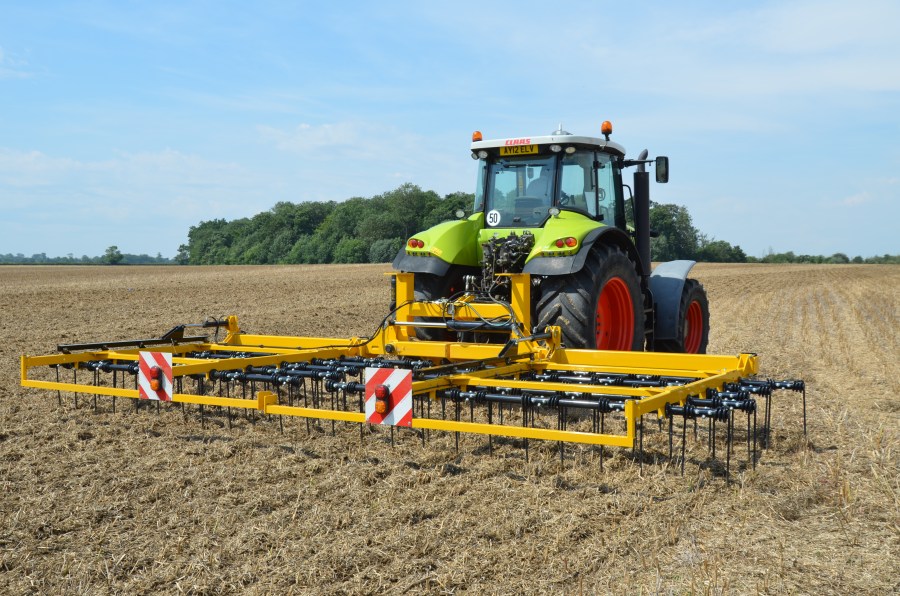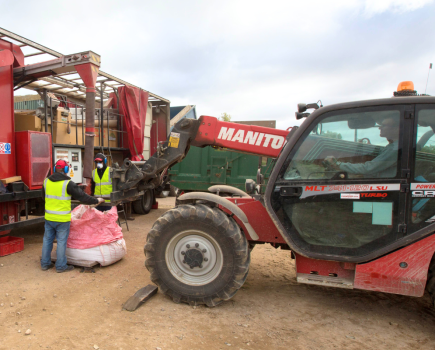Higher grain prices will not compensate for 10% to 20% lower yields on many farms following weeks of extreme dry weather leading up to harvest which sapped yield potential. Producers should therefore avoid over-spending on establishing next season’s crops, advises leading farmer and strip-seeding pioneer Jeff Claydon.
“Controlling costs when establishing crops over the next few weeks will be essential to protect their profitability when it comes to next year’s harvest. Having the patience to wait for the optimum conditions to allow effective stubble management and not over-cultivating land ahead of drilling will be hard to do, but essential to achieve clean, well-established crops going into winter,” Jeff Claydon states.
On the Claydon farms this year harvest was three weeks earlier than in 2017 and although no significant rainfall fell after the end of April the average winter wheat yield was just 10% below the 10 t/ha long-term average. Grain quality was excellent and prices significantly higher, with feed wheat sold at around £170/t.
Effective stubble management and crop establishment were key to this performance, aided by the new 6m Claydon TerraBlade, a low cost, mechanical method of controlling weeds in band-sown crops. Used in conjunction with herbicides throughout the season it ensured that there was no measurable adverse yield impact from grassweeds.
PATIENCE IS ESSENTIAL
The much earlier start to harvest in most parts of the country means that there is currently no panic to do anything in terms of establishing following crops, Jeff emphasises. Just the opposite in fact: farmers should bide their time until conditions are exactly right before carrying out any form of tillage.
Unlike 2017, when harvesting machinery and following operations caused significant damage to the structure of damp, fragile soils, most heavy soil farmland is currently like concrete, natural fissuring has remedied damage caused last season and harvesting had no adverse impact, eliminating the need to subsoil. But, after weeks of dry weather, rain in most areas over the last few days has wetted the top 25mm of soil, providing an ideal opportunity to begin an extended stubble management campaign to combat weeds, pests and diseases.
“Effective stubble management is an essential component of any efficient, sustainable, profitable crop production system, but operations must be well-timed and carried out correctly to ensure that they are effective and produce the full benefits,” Jeff emphasises.
“Mother nature has done much of the hard work for us this season, so most farms will be able to get away with far fewer cultivations. The urge to over-cultivate soils during the weeks leading up to drilling should be resisted, because heavy rain could turn it into a sticky mess that will take much longer to dry out and ultimately be detrimental to crop performance.”
When it comes to stubble management, Jeff says the ‘little and often’ approach is best, the key being to achieve an optimum tilth in which weeds and volunteers germinate rapidly so they can be killed using mechanical or chemical methods.
The key is not to move too much soil. This rules out conventional min-till which creates 100mm-125mm of tilth and can cause the soil to dry out, significantly slowing germination or burying weed and volunteer seeds so deep that they do not emerge until after the crop, creating major cost, product and control issues. Deeper cultivations also present a significant weather risk, as heavy rain will reduce the soil to a sticky mess with no structure or ability to support following machinery.
At the first suitable opportunity, Jeff goes over the stubbles with a 15m Claydon Straw Harrow which creates a fine 25mm-deep tilth. This helps to evenly distribute trash and crop residues, destroys any slugs or eggs that might be present and encourages weeds and volunteers to germinate. On 29 July, after twomonths of baking sun and drought followed by rain after harvest, one pass with the 15m straw harrow created a superb tilth to germinate weeds. Visit www.claydondrill.comto see a video of it working.
The implement covers 20 ha/hr and the operation uses just over 1 litre/ha of diesel, making it so fast and cheap that it can be repeated every seven to 14 days in favourable conditions. So little soil is moved that if the weather does turn wet this mini-tilth will dry quickly, allowing another pass with the Straw Harrow or drilling with a 6m Claydon Hybrid.
Even if no green shoots are visible on the surface, weeds and volunteers will still be growing under the chopped straw. Using the Straw Harrow when they are less than 20mm tall will kill 70% of them and repeating the operation several times will dramatically reduce populations.
Where necessary the Claydon TerraStar, asimple, low cost 6m shallow cultivator, might be used. Its 68 cross-blade rotors move slightly more soil than the Straw Harrow but much less than traditional tine or disc-based implements. Thefine tilth produced by the TerraStar contains a high level of humidity which encourages volunteers and grass weeds to germinate quickly. The implement also levels the field and allows manures or compost to be incorporated yet leaves the soil surface largely intact to support following machinery and allow water to drain away quickly from the surface.
The drill is one of the most important pieces of equipment on any farm and to ensure that it can establish a good, even crop with maximum yield potential it must be maintained in first-class condition.
The farming industry’s use of agrochemicals is under increasing scrutiny, the number of products is reducing, while those that remain are becoming more expensive and less effective. To help preserve access to the critical chemistry it is essential that farmers increase their use of mechanical and cultural methods to control weeds, pests and diseases. The key is to identify the optimum combination of techniques to use, which will differ from season to season, farm to farm and field to field.
REDUCING COSTS
With the agricultural sector facing considerable uncertainty in the run-up to Brexit farming businesses must reduce crop production costs significantly and establishment provides one of the largest areas for potential savings.
Claydon Opti-Till is the most versatile system on the market and dramatically reduces time, fuel, labour and wearing metal costs. It is five times faster and three times cheaper than plough-based techniques, and costs are less than half those of a min-till system.
Opti-Till provides the ideal machinery mix to quickly, efficiently and cost-effectively establish any crop that can be air-sown, creating the optimum amount of tillage for all soils and conditions. In addition to the Claydon TerraStar, Straw Harrow and TerraBlade which are used for stubble and weed management, the Opti-Till range also includes mounted and trailed drills from 3m to 8m, together with Cambridge rolls, all of which have been designed with a minimum of wearing and moving parts to keep operating costs low.
The high output of the Opti-Till system greatly improves timeliness, so owners can comfortably wait for optimum conditions before drilling, resulting in better structured, more fertile soils. The risk of erosion, water run-off and leaching of nutrients is also much reduced in soils that are better able to cope with extreme weather events, worms and birds thrive and crops develop their full potential.




